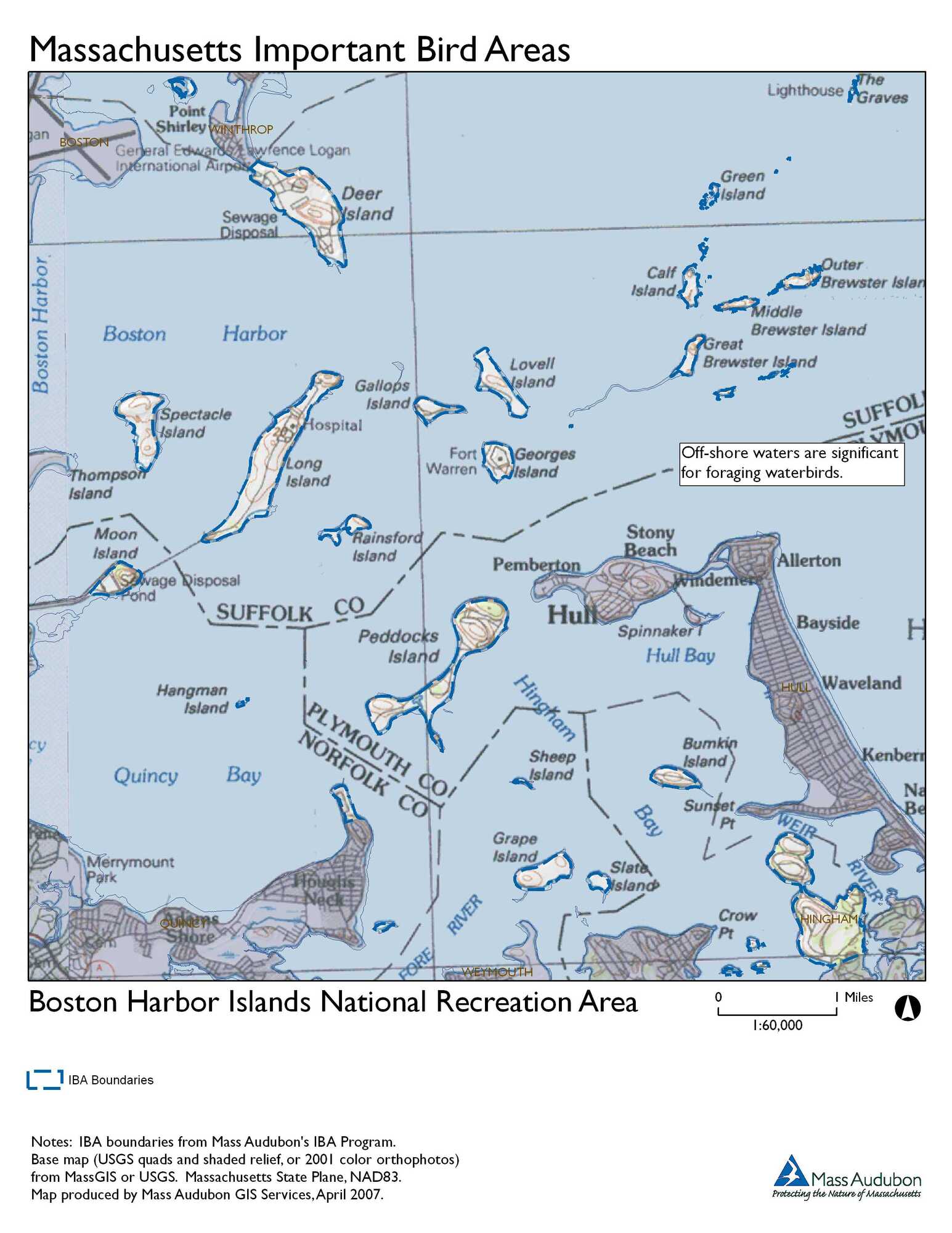BHI--Peddocks Island
BHI--Peddocks Island
Hull, Massachusetts 02045
Boston Harbor Islands Official WebsiteBoston Harbor Islands (National Park Service) webpage
Boston Harbor Islands map
Boston Harbor Islands National Recreation Area IBA
About this Location
This large island features military ruins, varied habitats, scenic hiking trails, and overnight camping.
At 184 acres, Peddocks is one of the largest, most diverse islands in the harbor. With the longest shoreline of any harbor island, Peddocks is composed of four headlands, connected by sand or gravel bars called tombolos. The total acreage at low tide is 288.
Peddocks features a new pier and hiking trails that pass a marsh, a pond, and coastal forests. These varied environments allow visitors to experience a wide range of natural beauty. Since the mid-1990s renewable energy has been highlighted with photovoltaic installations on the island.
Used by farmers since 1634, Peddocks Island’s proximity to the mainland ensured its prominent military role. Said to be the site of a patriot infantrymen’s raid on a Loyalist farm, Peddocks also saw over 600 patriot militiamen stationed on the island in 1776, to guard the harbor against the return of British troops. Home to Fort Andrews and active in harbor defense from 1904 to the end of World War II, 26 structures remain, including guardhouses, prisoner-of-war barracks, stables, a gymnasium, and a firehouse. It is also one of the many harbor islands used by American Indians before settlement by Europeans.
About Boston Harbor Islands
See all hotspots at Boston Harbor Islands
Located just minutes from downtown Boston, the Boston Harbor Islands include 34 islands and peninsulas spread over 50 square miles. Working with city, state, federal, and nonprofit partners, the park is a place where you can walk a Civil War-era fort, visit historic lighthouses, explore tide pools, hike lush trails, camp under the stars, or relax while fishing, picnicking, or swimming, all within reach of downtown Boston.
Between the horn of Cape Ann to the north and the defiant, jutting arm of Cape Cod to the south and east, the Boston Harbor forms a giant crescent on the central coast of Massachusetts and is the beating heart of the New England shoreline. The harbor sits within an ancient feature, known as the Boston Basin, which predates the formation of North America. Over the course of over 400 million years, it has seen tropical latitudes, multiple advances and recessions of the sea, and multiple periods of glaciation—the latter couple of which deposited and then carved many of the hills that currently dapple its surface. Today, within a vibrant metropolitan area, the Boston Harbor Islands provide a dynamic assembly of ecosystems, ranging from rocky, windswept shores to dense forests to developed and filled land—all with a long and complicated history of human use.
The hub islands, Georges and Spectacle, offer a world-class experience complete with hiking trails, picnic areas, interpretative walks, recreational programs, concessions, and state-of-the-art visitor centers. The more rustic islands, Peddocks, Bumpkin, Grape, and Lovells, provide camping adventures that offer a unique experience for locals and visitors to the Boston area. Thompson Island is open to the public via public ferries on specified weekends throughout the summer and fall.
Allow at least a half day to see one island and a day to see more. Georges, Spectacle, and Peddocks Island have fresh water and restrooms, while Lovells, Bumpkin, and Grape Island have composting toilets. There are no trash receptacles; please pack out what you pack in.
A visit to the Boston Harbor Islands is an opportunity to play, learn, serve, and work within the largest recreational open space in the Boston area.
The Boston Harbor Islands National Recreation Area comprises 34 islands ranging in size from less than 1 acre to 274 acres. A variety of habitats, including marine, rock cliffs, beaches, salt marshes, and forests support many different species in all seasons. Several species of special concern in Massachusetts have been observed on the Islands including Common and Least Tern, Barn Owl, and Common Loon. The Northern Harrier, a threatened species, also occurs on the islands. Significant numbers of colonial-nesting waterbirds, including Double-crested Cormorants, Black-crowned Night-Herons, and Snowy Egrets have been present for at least two decades. Migratory shorebirds, raptors, and songbirds utilize the harbor islands during the spring and fall, and great flocks of waterfowl overwinter there.
Features
Restrooms on site
Wheelchair accessible trail
Entrance fee
Content from Boston Harbor Islands (National Park Service) webpage and Boston Harbor Islands National Recreation Area IBA
Last updated February 18, 2024
